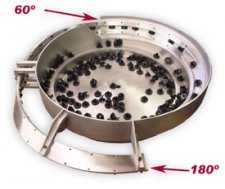Parts Feeding Tip: Bowl Tooling Fundamentals Part III: Twisting a Track
Twisting a Vibratory Track
ADI's vibratory bowl toolers sometimes say that the most difficult technique to teach is the proper way to design a twisted vibratory track. The latest CAD programs now help with the initial design of the track by allowing the designer to establish dimensional requirements. However, a great deal of customization is required as well as knowledge of the behavior of the parts under vibration.
Determining Requirements:
- First, determine which position the part will feed best in and produce the optimal rate.
- Test this using various bowls with different track angles.
- Use the natural position as the reference angle.
- Determine the angle at which the part will exit the bowl.
- Determine the orientation, in degrees, that is needed at the end of the track.
- Subtract or add, depending on
reference point, the start angle from the finish angle.
The resulting number will provide the amount, in degrees, that the track will need twisted.
Example A bowl best feeds this punch-clip with the insert end up. However, the clip is needed insert side down. So, the bowl feeds the clips end up using a flat track bowl that transitions to a 60º negative angle. Therefore, the clip leaves the bowl on a 60º positive angle, insert side facing in, and is twisted 120º to the horizontal position laying insert side face down.
Track Length
The track length is relational to the length of the product and the tangent points of the track. Essentially, the longer the product being fed is and the greater the degree of twist, the longer the track will need to be. As a products travel through the track, ensure the angular transition of the product is gradual: the angle of the leading product should not differ much from the lagging product angle, usually only several degrees difference. This helps prevent overlap and jamming in the track.

